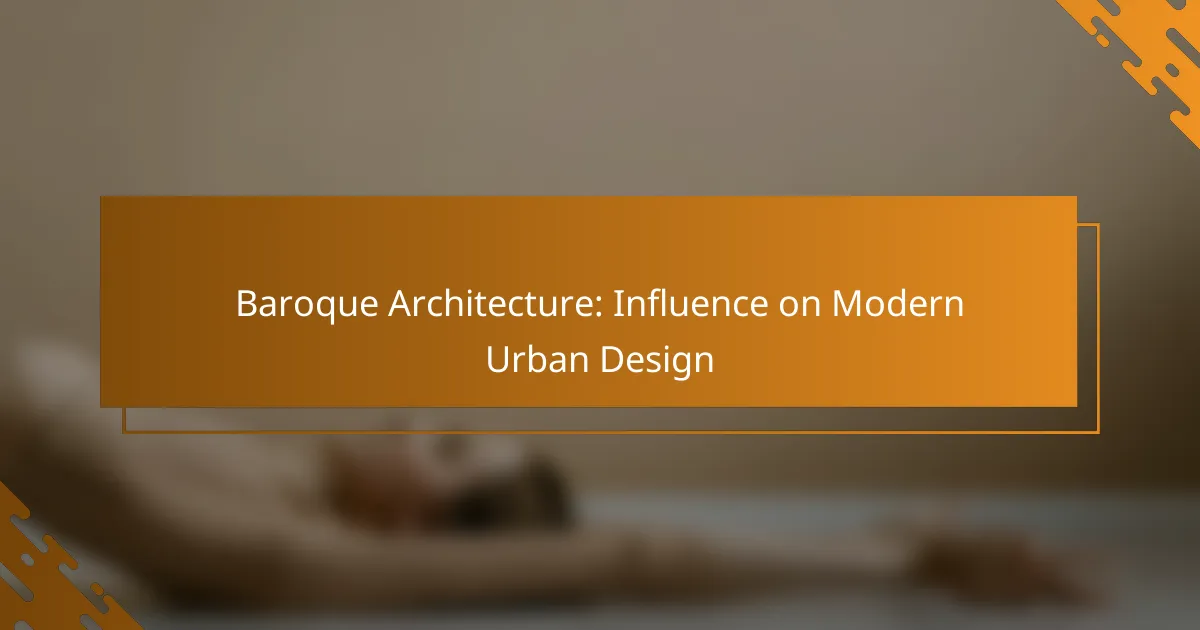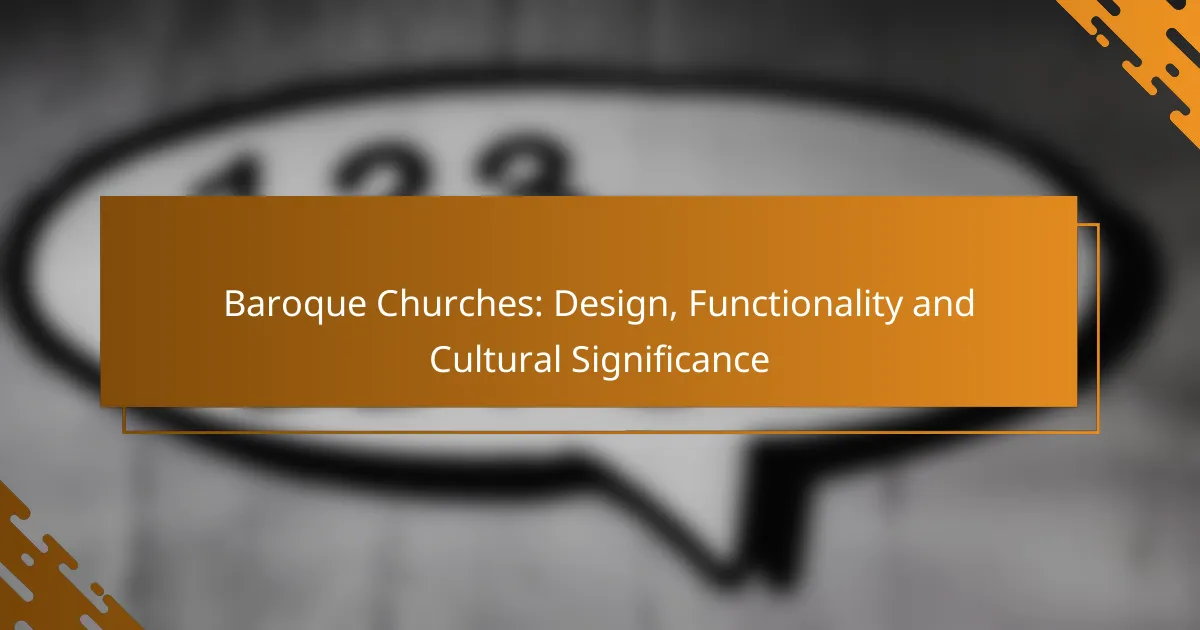Baroque architecture has left a lasting mark on modern urban design, characterized by its grandeur, symmetry, and the integration of public spaces. This style’s dramatic use of space and intricate details fosters visually captivating environments that enhance urban living. Cities like Paris, Vienna, and St. Petersburg exemplify this influence, showcasing grand architecture and elaborate layouts that echo the opulence of the Baroque period.
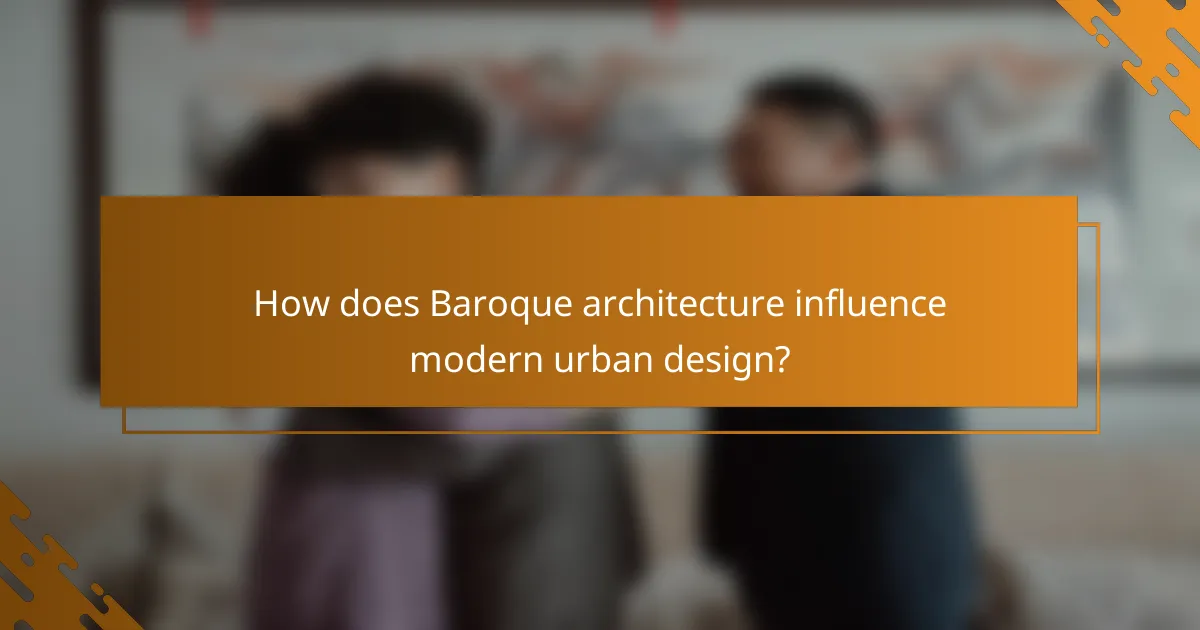
How does Baroque architecture influence modern urban design?
Baroque architecture significantly influences modern urban design through its emphasis on grandeur, symmetry, and the incorporation of public spaces. These elements create visually striking environments that enhance the experience of urban living.
Integration of grandeur and ornamentation
Modern urban design often draws inspiration from the grandeur and intricate ornamentation characteristic of Baroque architecture. This can be seen in the use of elaborate facades, decorative elements, and monumental structures that serve as focal points in urban landscapes.
For instance, contemporary public buildings may feature ornate entrances or detailed sculptures that echo Baroque styles, creating a sense of awe and importance. Cities like Paris and Vienna showcase such designs, where modern architecture incorporates historical ornamentation to maintain cultural continuity.
Use of symmetry and proportion
Symmetry and proportion are fundamental principles in both Baroque architecture and modern urban design. These elements contribute to a sense of balance and harmony within urban spaces, making them more aesthetically pleasing and functional.
In practice, urban planners often utilize symmetrical layouts for parks, plazas, and streets, ensuring that buildings and public spaces are proportionately scaled. This approach can enhance navigation and create a cohesive urban environment, as seen in cities like Washington, D.C., where symmetrical designs guide movement and interaction.
Incorporation of public spaces
The Baroque emphasis on grand public spaces is mirrored in modern urban design, where the creation of accessible and inviting areas is prioritized. Public squares, parks, and gathering spaces encourage community interaction and cultural activities.
Designers often focus on integrating green spaces and plazas that reflect the grandeur of Baroque public areas. For example, the revitalization of urban centers frequently includes large, open spaces that serve as venues for events, markets, and social gatherings, fostering a vibrant urban life.
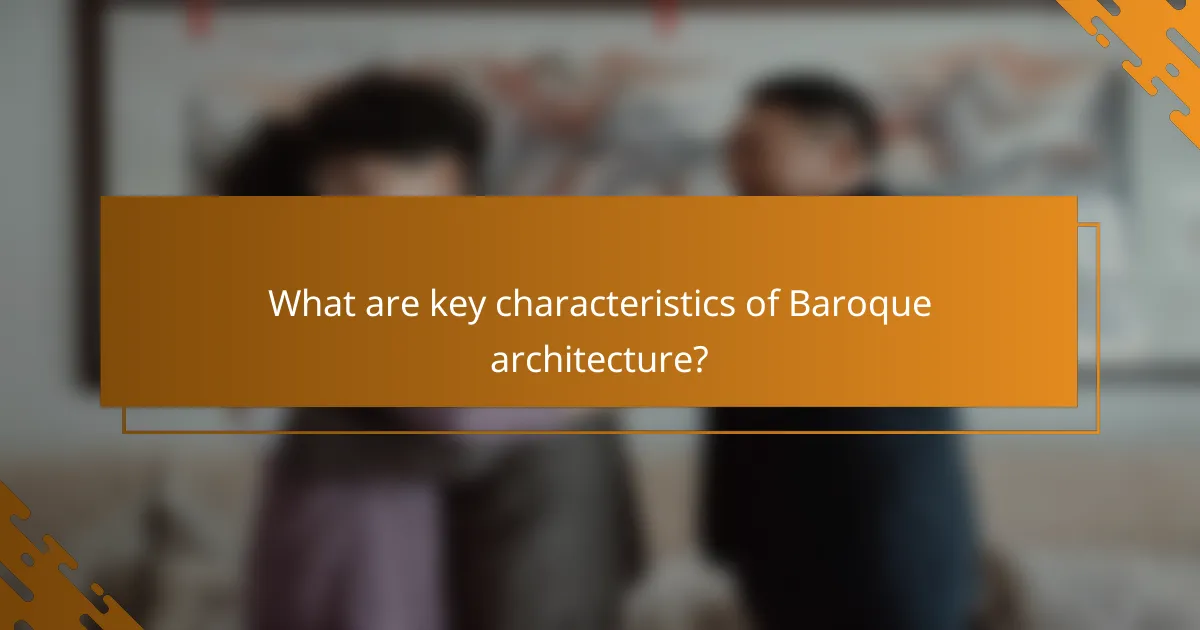
What are key characteristics of Baroque architecture?
Baroque architecture is characterized by its dramatic use of space, intricate details, and a sense of movement. It combines grandeur with emotional intensity, often employing bold forms and elaborate ornamentation to create visually striking structures.
Dynamic shapes and forms
Dynamic shapes and forms are central to Baroque architecture, often featuring curves, spirals, and irregular shapes that create a sense of movement. Buildings frequently incorporate oval and circular layouts, which contrast with the more rigid lines of Renaissance architecture.
Examples include the Church of San Carlo alle Quattro Fontane in Rome, where the undulating façade and interior create a fluid experience. Modern urban design can draw inspiration from these dynamic forms by integrating rounded structures or organic shapes into cityscapes.
Rich colors and textures
Baroque architecture showcases rich colors and textures through the use of materials like marble, stucco, and gilding. These elements enhance the visual impact of buildings, creating a luxurious and inviting atmosphere.
For instance, the use of deep reds and golds in the Palace of Versailles exemplifies this characteristic. Urban designers can apply similar principles by using varied materials and colors in public spaces to evoke a sense of richness and vibrancy.
Emphasis on light and shadow
Emphasis on light and shadow is a hallmark of Baroque architecture, achieved through strategic placement of windows and the use of contrasting colors. This interplay creates dramatic effects that enhance the emotional response to the space.
Buildings like St. Peter’s Basilica utilize light to highlight architectural features, making the structure appear more dynamic. In modern urban design, incorporating natural light through large windows or reflective surfaces can replicate this effect, enhancing the overall ambiance of public areas.
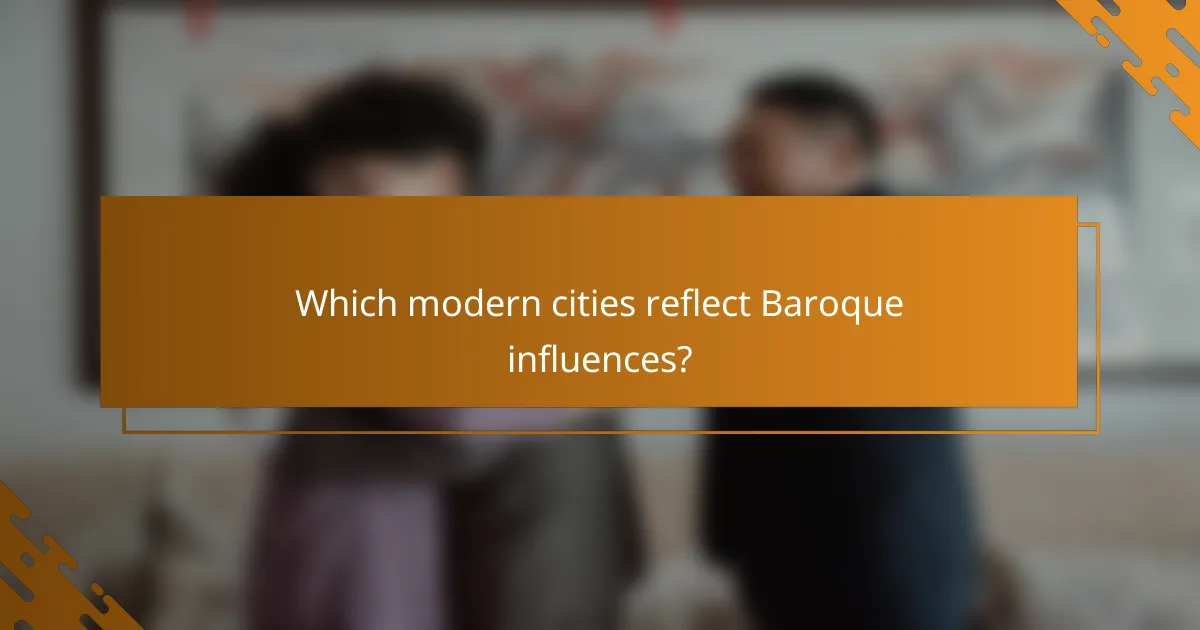
Which modern cities reflect Baroque influences?
Several modern cities showcase Baroque influences in their urban design, characterized by grandiose architecture, symmetrical layouts, and elaborate public spaces. Notable examples include Paris, Vienna, and St. Petersburg, each reflecting the opulence and artistic vision of the Baroque period.
Paris, France
Paris is a prime example of Baroque influence, particularly evident in its monumental structures and urban planning. The construction of the Palace of Versailles, with its expansive gardens and grand architecture, set a standard for royal residences and public spaces.
The city’s layout, featuring wide boulevards and grand squares, echoes Baroque principles of symmetry and order. Landmarks like the Place de la Concorde and the Palais Garnier exemplify the dramatic flair and intricate detailing characteristic of Baroque design.
Vienna, Austria
Vienna’s urban landscape is deeply rooted in Baroque architecture, with numerous palaces and churches that reflect this style. The Schönbrunn Palace, a UNESCO World Heritage site, showcases the grandeur of Baroque aesthetics with its lavish interiors and expansive gardens.
The city’s historic center, featuring St. Stephen’s Cathedral and the Belvedere Palace, highlights the use of dramatic forms and elaborate ornamentation. Vienna’s commitment to preserving these architectural treasures contributes to its reputation as a cultural hub.
St. Petersburg, Russia
St. Petersburg, founded by Peter the Great, is heavily influenced by Baroque architecture, particularly in its palaces and cathedrals. The Winter Palace, a stunning example of Baroque design, serves as a symbol of imperial power and artistic achievement.
The city’s layout, with its canals and grand avenues, reflects the Baroque emphasis on grandeur and visual impact. Landmarks like the Church of the Savior on Spilled Blood showcase intricate facades and vibrant colors, embodying the spirit of Baroque artistry.

How can urban designers apply Baroque principles today?
Urban designers can apply Baroque principles by emphasizing grandeur, symmetry, and dramatic focal points in modern city layouts. These elements can enhance aesthetics and functionality, creating spaces that engage and inspire the public.
Creating focal points in urban spaces
Focal points are essential in Baroque design, drawing attention to significant structures or public squares. Urban designers can implement this by placing monuments, sculptures, or distinctive buildings at key intersections or open areas, encouraging exploration and interaction.
Consider using elements like water features or landscaped gardens as focal points to enhance visual appeal. For example, a central plaza with a striking fountain can serve as a gathering place, promoting social interaction and community events.
Designing multifunctional public areas
Baroque architecture often features multifunctional spaces that serve various purposes. Urban designers should create public areas that accommodate markets, performances, and recreational activities, ensuring they meet diverse community needs.
Incorporating flexible design elements, such as movable seating or adaptable stages, can enhance the utility of these spaces. This approach not only fosters community engagement but also maximizes the use of urban land.
Enhancing pedestrian experiences
Baroque principles advocate for grand, inviting pathways that enhance the pedestrian experience. Urban designers can achieve this by creating wide, tree-lined boulevards that encourage walking and cycling, while integrating art and seating along the route.
Incorporating pedestrian-friendly features, such as ample crosswalks and traffic calming measures, can improve safety and accessibility. Additionally, ensuring that these pathways connect to key destinations can promote a vibrant urban environment.
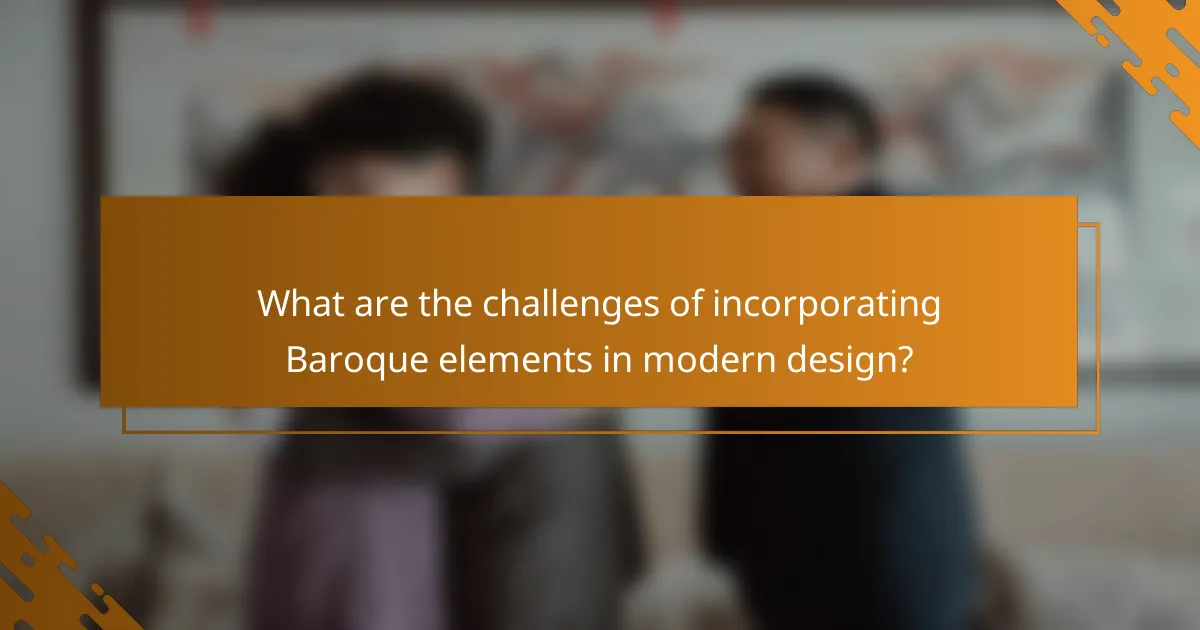
What are the challenges of incorporating Baroque elements in modern design?
Incorporating Baroque elements into modern design presents challenges such as maintaining historical authenticity while meeting contemporary needs. Designers must navigate the complexities of aesthetic integration, cost implications, and regulatory constraints to successfully blend these ornate features into urban environments.
Balancing historical authenticity with modern needs
Achieving a balance between historical authenticity and modern needs requires careful consideration of design principles. Baroque architecture is characterized by grandeur and intricate details, which can clash with minimalist modern aesthetics. Designers should aim to incorporate Baroque elements in a way that respects their historical context while ensuring functionality and relevance in today’s urban landscape.
For instance, using Baroque-inspired facades on modern buildings can enhance visual interest without overwhelming the structure’s purpose. This approach allows for a dialogue between the past and present, creating spaces that are both evocative and practical.
Cost implications of ornate designs
The cost of incorporating ornate Baroque designs can be significant, as these features often require specialized craftsmanship and materials. Budgeting for such elements is crucial, as expenses can vary widely depending on the complexity of the design and the materials used. In general, projects that integrate Baroque features may see costs increase by a notable percentage compared to simpler designs.
To manage costs effectively, consider prioritizing key Baroque elements that provide the most visual impact while keeping the overall budget in check. This might involve selecting specific decorative features rather than an all-encompassing approach, allowing for a more sustainable financial plan.
Regulatory constraints in urban planning
Urban planning regulations can pose challenges when integrating Baroque elements into modern designs. Many cities have strict guidelines regarding historical preservation, which can limit the extent to which Baroque features can be added or modified. Understanding local regulations is essential to avoid potential legal issues and ensure compliance with preservation standards.
Engaging with local planning authorities early in the design process can help identify any restrictions and facilitate smoother project approvals. Additionally, collaborating with preservation experts can provide insights into how to harmonize Baroque elements with existing urban frameworks while adhering to regulatory requirements.
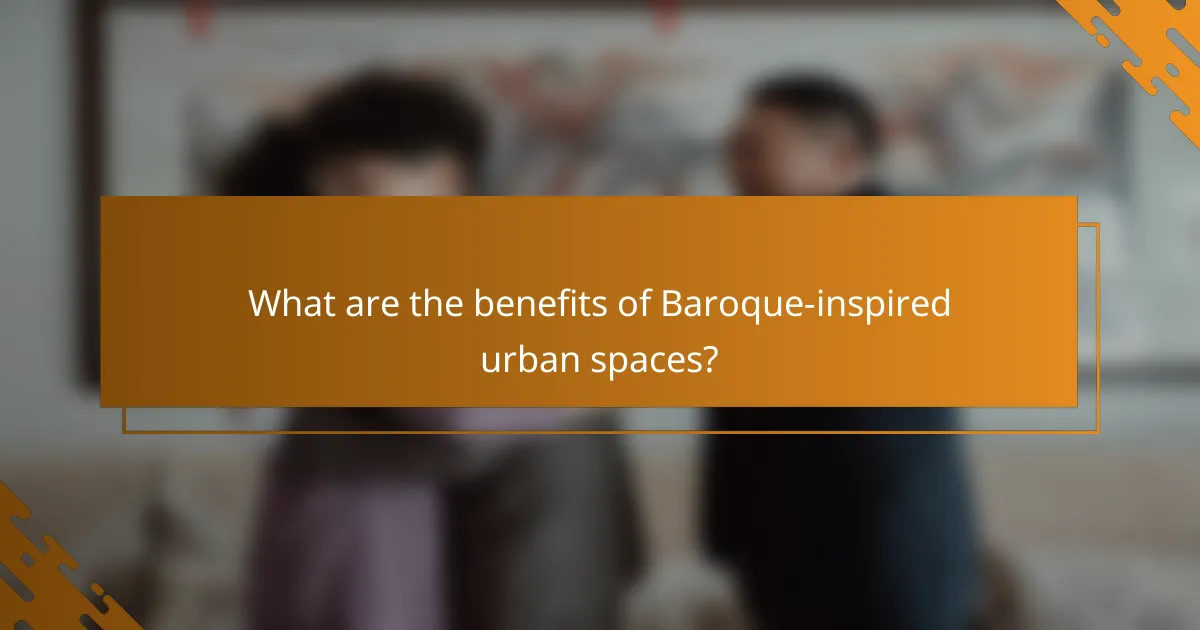
What are the benefits of Baroque-inspired urban spaces?
Baroque-inspired urban spaces offer a range of benefits, including enhanced visual appeal and improved social interaction. These designs often incorporate dramatic elements and grand scales that can elevate the experience of public spaces, making them more inviting and engaging for residents and visitors alike.
Enhanced aesthetic appeal
Baroque architecture is characterized by its ornate details, dynamic forms, and bold contrasts, which can significantly enhance the aesthetic appeal of urban environments. By integrating these elements into modern design, cities can create visually captivating spaces that draw people in and encourage exploration.
Incorporating features like grand staircases, elaborate facades, and expansive plazas can transform ordinary streets into extraordinary experiences. For example, cities like Vienna and Paris utilize Baroque principles to create stunning public squares that serve as focal points for community gatherings and events.
When designing Baroque-inspired spaces, consider using a mix of materials, textures, and colors to create depth and interest. Avoid monotony by ensuring that different elements complement each other while maintaining a cohesive overall theme.
